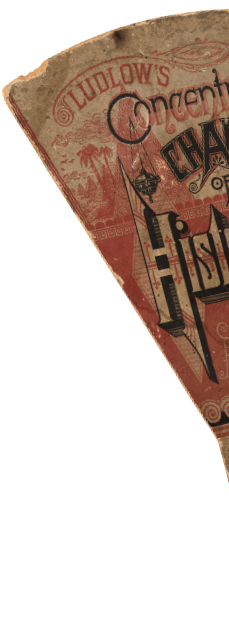
Concentric Chart of History
A Chronographic Machine
In his 1885 Ludlow’s Concentric Chart of History,James Meeker Ludlow (1841-1932) built a chronographic machine. The principle was simple: historical charts formatted in concentric circles, chopped into wedges, and hinged at the point. Nothing especially high tech, but an intriguing mechanism for combining the information depth of a book with the visual immediacy of a chart.
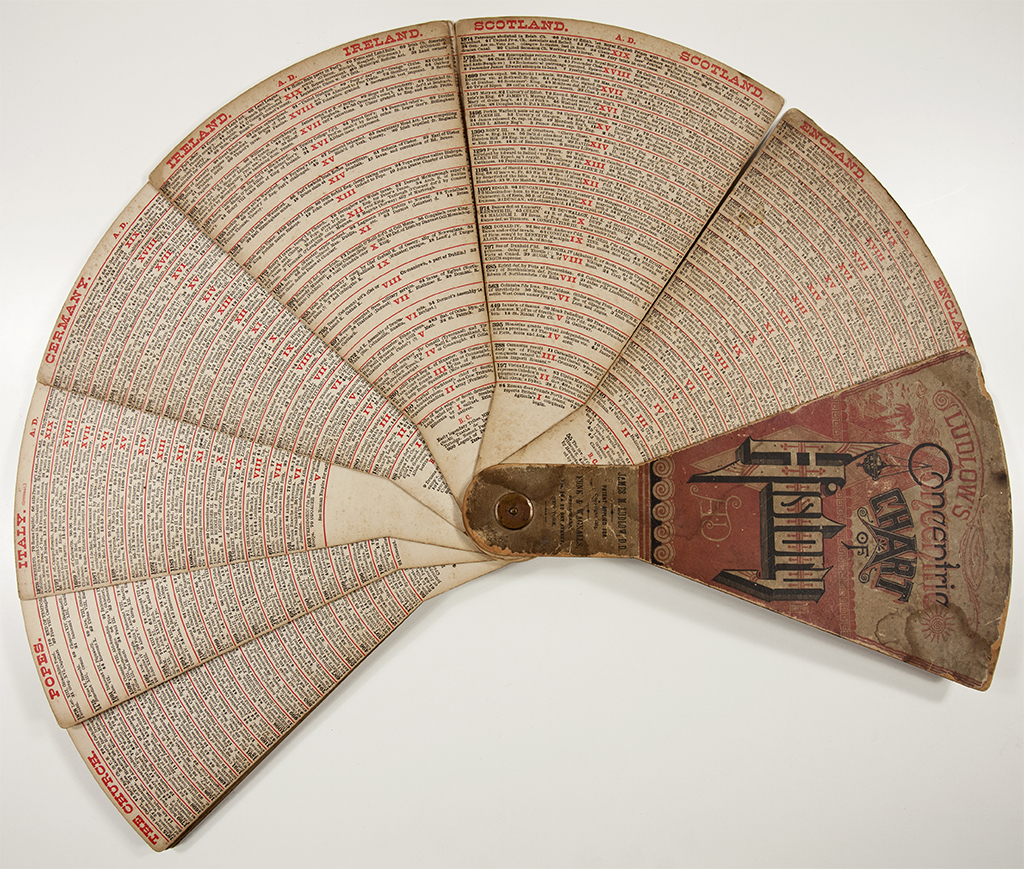
Ludlow’s Concentric Chart of History (1885), front fanned
In 1885, Ludlow was at a high point in a distinguished career. In 1861, he had graduated from the College of New Jersey (later called Princeton), and then in 1864 from Princeton Theological Seminary. He was soon posted as pastor to the Collegiate Reformed Church of New York where he oversaw the construction of a new $600,000 structure on Fifth Avenue, to Westminster Church, Brooklyn, and then the wealthy First Presbyterian Church in East Orange, New Jersey. In 1879, As pastor of Westminster Church, he presided over the heavily publicized ecclesiastical trial of the popular Reverend T. DeWitt Talmage, one of the most famous orators of his day. Ludlow’s careful handling of a potentially incendiary event earned wide praise. Two years earlier, Ludlow had survived his own ecclesiastical controversy when he made public objection to the rotation system that would move him on from his position as minister on Fifth Avenue. In 1885, Ludlow declined the presidency of Marietta College. Later, in 1913, Ludlow conspicuously defended Woodrow Wilson’s controversial decision to attend a Catholic Mass in a “gracious” spirit. He was a director and Trustee of the Union Theological Seminary in New York.
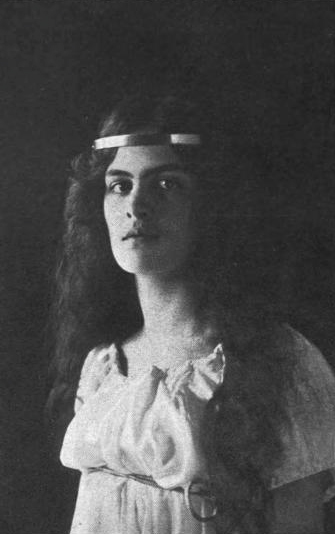
Frontispiece from James M. Ludlow, Deborah: A Tale of the Times of Judas MacCabaeus (1901). “Dion paused by the oaken door in the wall of the Jew’s house….The Greek had scarily time to knock at the outer entrance when the door flew open, and with the cry ‘Father!’ a young girl’s arms were about the old man….The girl was apparently about seventeen years of age, tall and lithe, with sufficient muscle to give that exquisite grace which only accompanies strength. Her hair, bound about the temples with a single fillet of sliver, fell in wavy profusion of jet black upon a white linen chiton. This was gathered at the shoulders, and left fully exposed a neck which might have illuminated a copy of Solomon’s Song.”
Ludlow was also a scholar and a popular writer, penning numerous theological-historical romances set in ancient and medieval times and new hymns as well. In 1881, he traveled in Palestine and returned to write numerous books set in the region including The Captain of Janizaries (1887), A King of Tyre (1891), The Age of the Crusades (1896), and Deborah: A Tale of the Times of Judas MacCabaeus (1901), theological tracts, and miscellaneous guidance books including Incentives for Life, Personal and Public (1902), a work he dedicated to “Theodore Roosevelt, President of the United States, with affectionate recollection of a boy in the pew who has since in public life and personal character signally exemplified the precepts contained in this book.” As concerns history, Ludlow’s novels received mixed reviews, in 1897 The American Journal of Theology found his account of the Crusades more “romantic” than “accurate,” which in no way deterred Ludlow from cheerfully publishing more. Nor did it appear to dampen the public appetite. Ludlow’s new releases were approvingly noted by the New York Times and his reading announced in the Brooklyn Eagle.
It is not hard to see how a popular writer and history buff such as Ludlow would come to be interested in chronological charts. In a sense, the very essence of the chronological chart is balance the propositions of “and then…” and “meanwhile.” In the grid layout, traditional since the Chronicle of Eusebius, composed in the fourth century C. E., empires were arraigned in columns on the page and years in horizontal rows. Scanning downward revealed the chronological series, “and then… and then”; scanning across revealed synchronisms, “meanwhile somewhere else.” And it is no accident that the historical chart of this sort would become a popular genre at the time of the emergence of the historical novel. The novel was in some senses an emplotment of the chart.
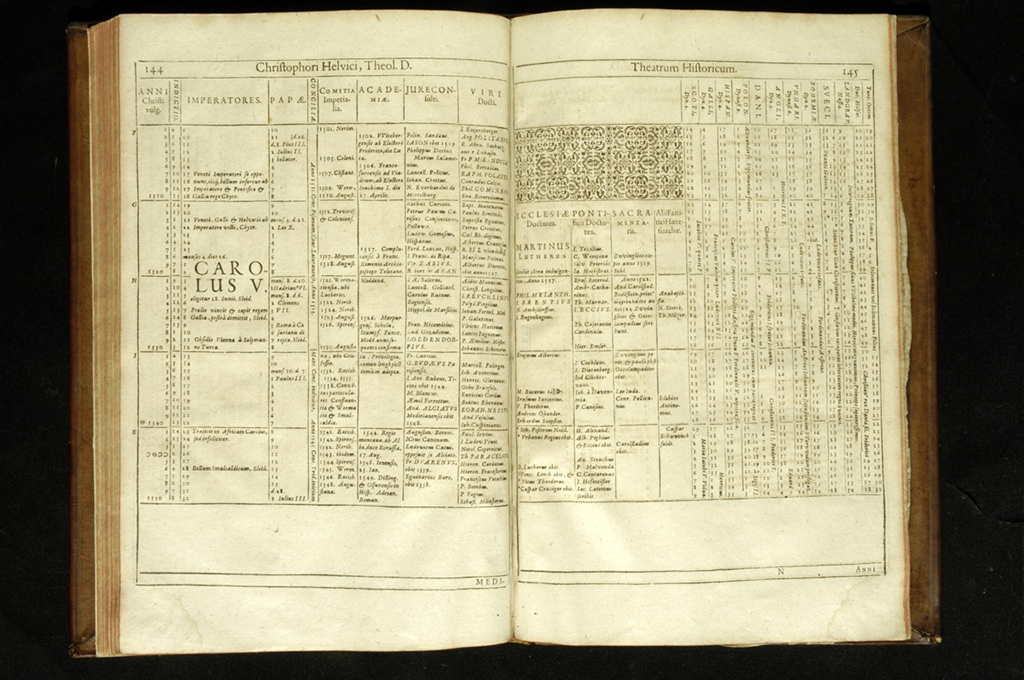
Years 1510-1550 in Christoph Helwig, Theatrum Historicum (1609), following the grid model of Eusebius
At the same time, the chart was a departure for Ludlow, whose other works were narrative and discursive. It was his major foray into a work of reference and almost certainly his only patent. It was also a departure for his publishers, Isaac Funk (1839-1912) and Adam Wagnalls (1843-1924), whose company, founded a decade earlier, was still principally a publisher of theological works. It would be another decade still before Funk and Wagnalls published its dictionary, and their famous encyclopedia would not appear until 1912. For them, the Chart was a beginning too.
Ludlow was not the first to try to break apart the chronological chart or transform it into a technical device. Over a century earlier, in 1753, the Paris physician Jacques Barbeu-Dubourg (1709-1779), had produced and publicized what he called a machine chronographique. Barbeu-Dubourgmade a 53-foot-long chronological chart, spooled it onto rollers, and inserted it into a portable, custom-made box. Users would open the box like a book and then move through history by cranking two metal handles. Barbeu-Dubourg did not produce his machine in great numbers, but he did earn praise for it in Diderot’s Encyclopédie, which devoted an entire article to the device.
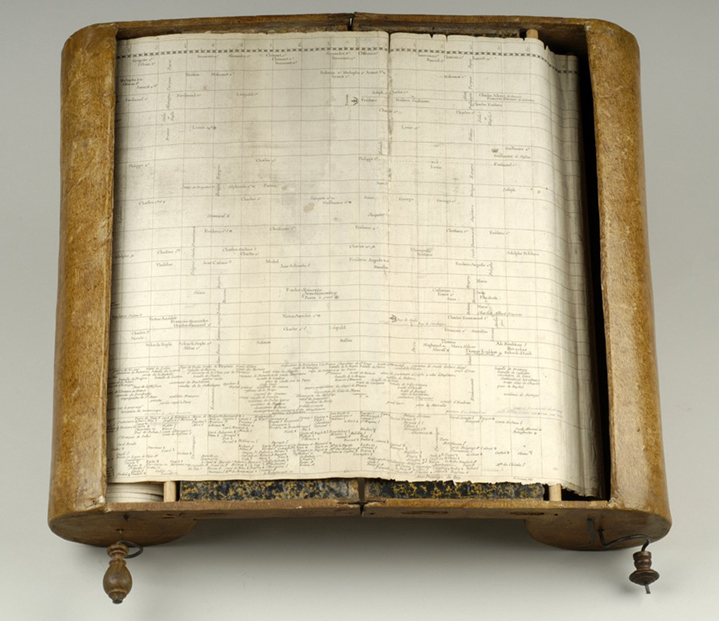
Jacques Barbeu-Dubourg, Machine chronographique (1753)
A few similar devices were published in later years including a highly popular and durable chronology scroll designed by the Oregon pioneer minister Sebastian Adams and printed on a chromolithograph by the versatile Cincinnati firm, Strobridge & Company—also publishers of many posters for the Barnum & Bailey Circus—in 1871. Adams’s chart, published under many different titles and in many editions, remains in print today.
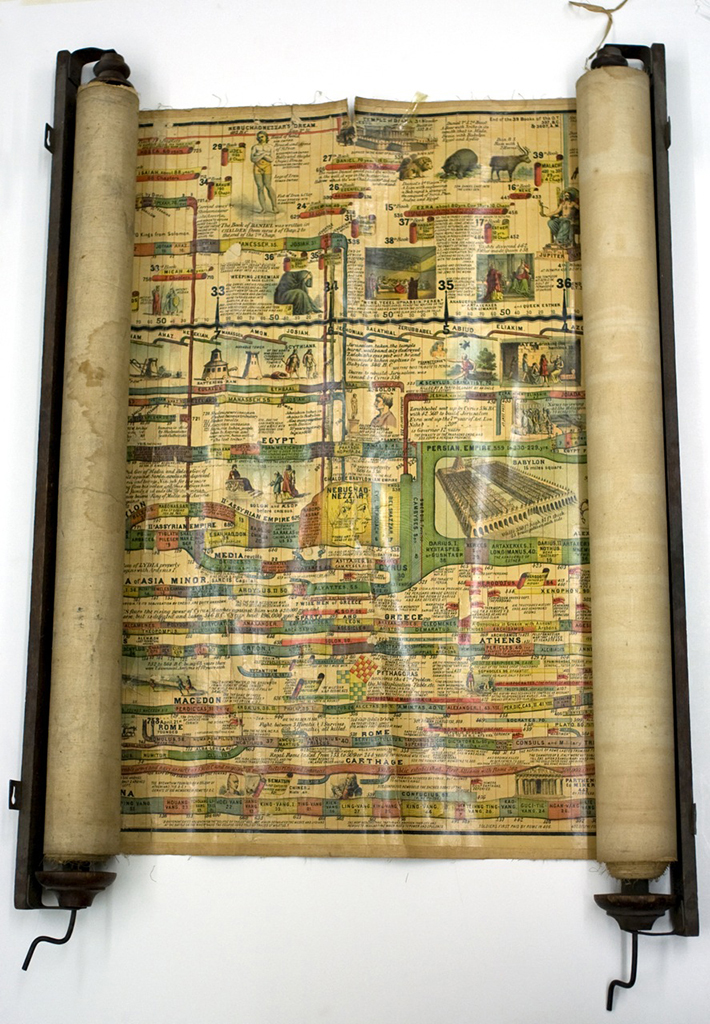
Sebastian Adams, Synchronological Chart (1871)
An even earlier precedent for Ludlow’s chart was the Discus chronologicus published by the German printer, Christoph Weigel, around 1723, which also projected historical chronology onto a concentric disk. Weigel’s invention differed from Ludlow’s in a number of ways. In the first place, it was a single sheet. The moving part was a pointer attached at the center of the chart which could be rotated to any axis. It treated space and time in a way directly contrary to Ludlow. On Ludlow’s chart, rings were centuries, wedges were nations. On Weigel’s chart, it was the reverse. Each nation was represented by a ring. Each century by a wedge. The rotating pointer was a key that helped users identify which ring represented which country.
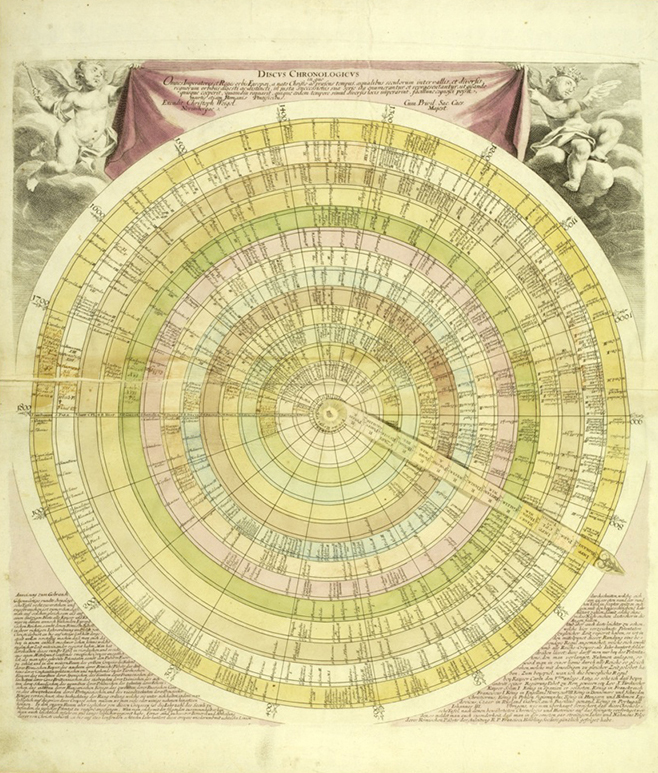
Christoph Weigel, Discus chronologicus (about 1723)
Dozens of different chronological devices were created over the course of the following two centuries up to and continuing after Ludlow, some of which echoed the logic of Ludlow’s own. For example, in 1897, a Portland, Oregon rabbi, Jacob Bloch, patented a Chronological Skeleton Chart in the form of a spiral. Bloch promoted as a core feature of his chart an aspect for which Ludlow had been criticized in reviews, that is, by the nature of the design, less space is allotted for ancient history than for modern. For Bloch, this suited both our access to and demand for a higher level of detail in our knowledge of recent history compared to that of ages long passed.
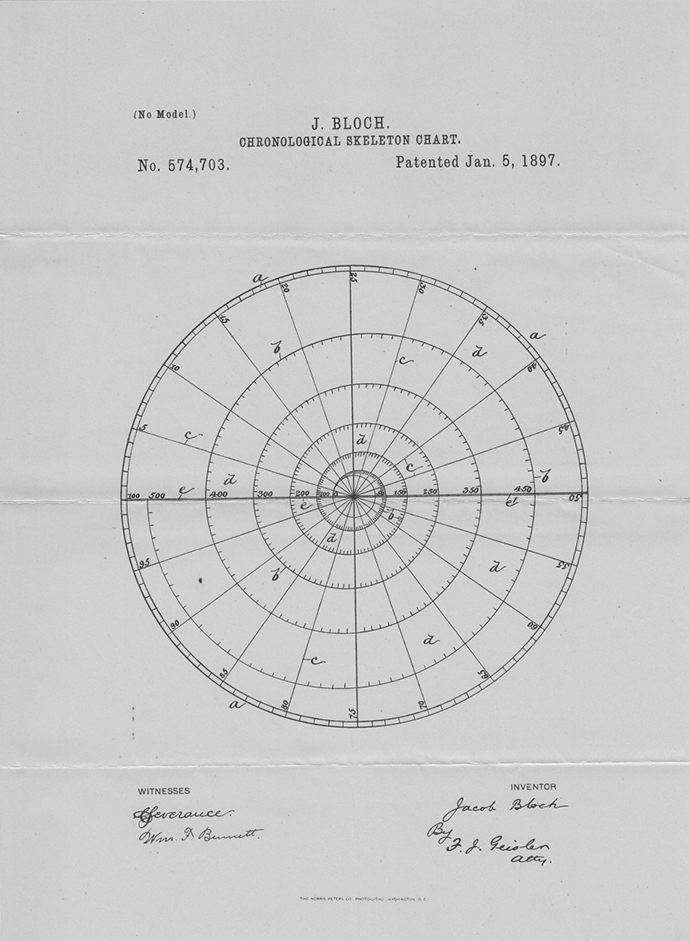
Jacob Bloch, Chronological Skeleton Chart (1897)
But, even among these various devices, Ludlow’s has a particular charisma. It does a lot, but it doesn’t try to do too much. There is order here and a system. But it is a system of presentation, not a system of history. Ludlow makes no great claim to reveal underlying truths. For him, history is essentially narrative. His concentric bands are crammed with events in series, with never quite enough space for them all. Ludlow’s is a chart that lends itself to browsing and reading. It is, in so many ways, an almost-book, or from a more modern perspective, maybe an augmented book, allowing us to see how history hinges on chronology.
